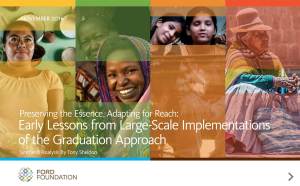Graduation Approach Synthesis and Four Case Studies (English)
The challenge
Inequality remains at very high levels globally, limiting prospects for overall economic growth as well as opportunities for the poor and disadvantaged to get ahead. Reducing inequality requires addressing the incomes and assets of the poor and addressing the alarming gap between those at the top and bottom of the economic ladder. Unfortunately, most development interventions, including microfinance and livelihood development programs, have not addressed the needs of the extreme or ultra-poor because these populations tend to be the hardest to serve: they are socially and geographically isolated, own few or no assets, have limited livelihood prospects, and often suffer from poor health.
What we did
One of the most promising approaches for promoting the social and economic mobility of the extreme poor has been the “Graduation Approach,” originally developed as the “Targeting the Ultra Poor” program by BRAC in Bangladesh. The Graduation Approach is a holistic livelihoods program designed to address the multi-dimensional needs of extreme poor households. It consists of five core components: time-limited consumption support; a savings component; an asset transfer; training in how to use the asset; and life skills coaching and mentoring. The theory of change underlying the model is that this mix of interventions, offered in the appropriate sequence, would help the ultra-poor to “graduate” out of extreme poverty within a defined time period.
The Ford Foundation partnered with the Consultative Group to Assist the Poor (CGAP), a global partnership of development organizations housed at the World Bank, to adapt and test the Graduation Approach through 10 pilot projects in eight countries in Asia, Africa, and Latin America between 2006 and 2014. While the findings from the CGAP-Ford Foundation pilots were extremely positive, the question of how to operate the Graduation Approach at scale remained. The very factors believed to make it so effective—highly personalized, wrap-around services delivered with compassionate, skilled, and individual attention—also make the “classic” Graduation Approach time- and labor-intensive and costly. CGAP, Ford and their partners then explored how best to support large-scale adaptations and implementations of the Graduation Approach, especially by governments. The results of four of those adaptations are the subject of this series of case studies, published in 2016. Three of the cases (Colombia, Ethiopia and Peru) describe government-led programs; the fourth (India) covers the Graduation work of non-governmental organization (NGO) Bandhan Konnagar.
What We Learned
The synthesis analysis is an overview of the four programs’ initial efforts in scaling up the Graduation Approach. It focuses primarily on lessons learned that may be valuable for other institutions and agencies implementing, or considering implementing, a large-scale Graduation program. It also offers some general observations about the evolution of the Graduation Approach and the priorities of the community of practice that has grown up around it.
Overall, the process of designing and planning a Graduation program takes time and expertise. It involves, at a minimum, deciding how to target and select participants; how to recruit, retain, and supervise staff; how to identify and manage the necessary partnerships to carry out the work; and how to define success.
Some key lessons learned from the four programs are:
- Initial results indicate that the Graduation Approach significantly changes the lives of participants. The incentive provided by the asset transfer, however modest, provides a much-needed capital infusion for the participants to build their businesses. In combination with the development of savings discipline and the technical training and life skills coaching, participants experience significant improvements in income, assets, and self-confidence.
- The Graduation Approach has shown strong promise of being adaptable enough for implementation at significant scale, both by governments and by NGOs. The scale-ups documented in the four case studies indicate that adaptations to suit local contexts, participant needs, and resource constraints can be managed successfully.
- Given the varied and complex nature of the interventions included in the Graduation Approach—which span social protection, livelihoods development, and financial services—often no single agency is able to implement the full range of services. The lead implementing agency must often serve as the focal point for partnerships and alliances with other agencies and organizations, including NGO advisers and co-implementers.
- It is challenging yet crucial to define “graduation”—to develop clear, context-specific criteria to gauge whether participants have succeeded in moving out of extreme poverty and into sustainable livelihoods within the time parameters set. These criteria are generally a mix of quantitative and qualitative indicators. “Graduating” does not necessarily mean that participants are no longer eligible for other government services, such as conditional cash transfers, as eligibility criteria for such programs may be distinct from Graduation criteria. Indeed, participants’ capacity to continue increasing their economic and social resilience may depend on their continued eligibility for government services, such as conditional cash transfers and healthcare.
- The experience of government-led Graduation programs has demonstrated that the Approach can be successfully integrated into existing social protection initiatives, especially conditional cash transfer programs. Successfully striking that balance—between preserving the essence while adapting for scale—is probably the most critical overarching challenge facing the Graduation community of practice. The very factors that make the Graduation Approach so powerful are also the factors that make it complex and expensive.
